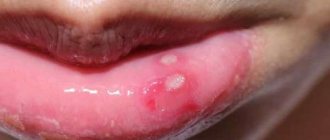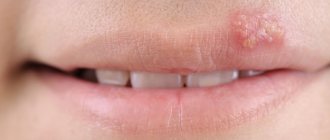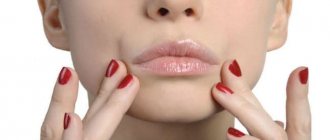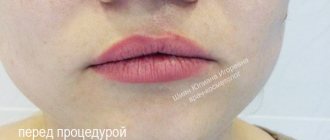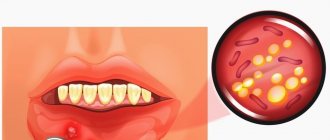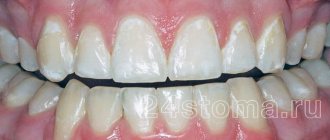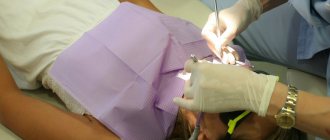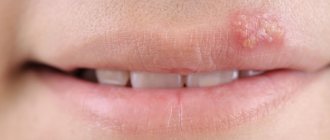Causes of white spots on the lips of a newborn baby
The appearance of white spots on the lips of an infant may be due to:
- candidal stomatitis (thrush) - due to the activation of the opportunistic yeast-like fungus Candida. This is the most common cause of the appearance of white spots on the lips of children in the first year of life;
- bacterial stomatitis - an attack of microbes, usually strepto- or staphylococci, on the oral mucosa weakened by the provoking factor;
- herpetic infection - herpes simplex virus type I, activated against the background of a decrease in local or general immunity;
- allergic stomatitis - when the oral mucosa is exposed to substances to which the child has an abnormally high sensitivity.
Factors that create a favorable environment for the introduction of the pathogen and the development of the disease include:
- low immune defense;
- prematurity;
- artificial feeding;
- insufficient hygiene of the infant's oral cavity, maternal nipple, bottles, pacifiers, nipples;
- microtrauma of the mucous membrane - thermal, mechanical or chemical - in which an entrance gate for infection is formed;
- nutritional imbalance - lack of breast milk or a mixture of vitamins, macro- and microelements;
- difficulty passing air through the nasal passages - breathing through the mouth dries out the mucous membrane, increasing the risk of microtraumas and infections;
- pathologies of the digestive and endocrine systems - diabetes, hepatitis, dysbacteriosis.
For stomatitis to occur, a combination of two conditions is necessary: activation of the pathogen and predisposition of the mucous membrane to the disease due to the influence of the provoking factor.
Causes of white plaque in a child
Young mothers panic when they see a white coating on their baby’s tongue. First of all, this is due to ignorance of the causes of the condition, which are divided into natural and dangerous to health.
When there is no reason to worry
Babies may experience a white coating after feeding
Babies who are breastfed may develop a white coating in their mouth after feeding. This is normal.
The same situation is observed in babies who are fed artificial formulas.
In both cases, the plaque disappears 10–15 minutes after finishing the meal. The oral cavity again acquires a healthy pink tint.
Such plaque on the tongue, inner surface of the cheeks and palate also forms after regurgitation. It is lumps of undigested milk and looks like cottage cheese.
Important! Plaque can be easily removed. To do this, wrap a clean finger in a bandage and rub it over the surface covered with the white formation.
When to see a doctor
When white plaque is accompanied by an increase in body temperature, you need to consult a doctor.
You need to visit a pediatrician in the following cases:
- the baby refuses to eat, is capricious, sleeps restlessly;
- there are diaper rashes on the body;
- there is an increase in body temperature;
- there is a lot of plaque in the oral cavity, it is difficult, but still not completely, to be removed;
- white mass appears regularly;
- plaque forms on the genitals.
The reasons for this lie in diseases.
Diseases of infectious and dental origin
Such diseases include:
Associated symptoms
The appearance of white spots on the lips may be accompanied by associated symptoms.
- The appearance of vesicles in herpes may be preceded by a sensation of itching, burning, tingling at the site of the virus attack.
- Aphthae (erosions) formed during bacterial or fungal stomatitis are very painful, especially when sucking, irritation with milk or food.
- Massive lesions of the mucous membrane by any type of pathogen can be accompanied by lethargy, refusal to eat, crying, and drooling.
In the absence of treatment or the addition of a secondary infection, the aphthae can undergo necrosis, to which the baby’s body reacts with symptoms of general intoxication: a rise in temperature to 39-40 ° C, anxiety, fever, and an unpleasant odor from the baby’s mouth.
Immunity-weakening diseases - the root causes of white spots on a child’s lips are manifested by organ or systemic symptoms: dyspeptic disorders, pain, bloating, frequent regurgitation, etc.
Methods of treating diathesis
When dealing with diathesis in a young child, the main thing is to choose the right diet, excluding foods that may cause an allergic reaction.
For a child in his first year of life, it is very important to receive breast milk.
The proteins of human milk are easily broken down by the baby's enzymes and are completely devoid of allergic properties. However, a nursing mother must also follow a diet excluding fish, poultry, tomatoes, chocolate, smoked meats, spices and other allergenic foods.
When mixed feeding, the child should not be given some juices: orange, carrot, tomato. Introduce any new product carefully - from a small amount. It is important to prevent an allergic exacerbation, and at the same time, to give the baby’s body everything it needs for its development.
Specialist consultation
The Family Doctor pediatric allergist-immunologist will help you deal with your child’s skin problems, determine the cause of allergies, and also build a rational diet that is suitable specifically for your child.
Make an appointment Do not self-medicate. Contact our specialists who will correctly diagnose and prescribe treatment.
Rate how useful the material was
thank you for rating
Diagnostic methods
Upon examination, a specialist can determine that the child has stomatitis. However, identifying the root cause of its occurrence and the type of damaging factor can be difficult for him.
For this purpose, additional examination is carried out:
- blood for polymerase chain reaction - to determine the nature of the pathogen, allows you to confirm herpes;
- scraping from the aft - to identify the pathogen (streptococcus, staphylococcus, etc.), its susceptibility to antibiotic therapy;
- performing allergy tests, blood testing for immunocomplexes, conducting an immunogram - to study the body’s response to allergens.
According to indications, a hardware ultrasound examination, consultation with a pediatrician, and specialists are prescribed.
Symptoms of diathesis
Inflammation of the skin during diathesis is the body's reaction to contact with an allergen. The main way an allergen enters a child’s body is food, but a reaction to contact with the skin of the allergen is also possible (the allergen, for example, can be components of washing powder that get on clothes during washing, plant pollen, dust, animal hair, etc.).
Diathesis in children under 3 months of age
The first manifestations of diathesis most often appear at the age of 2-3 months. This:
- diaper rash that does not disappear even with careful care;
- profuse prickly heat with mild overheating;
- sebaceous crusts of gray-yellow color on the head in the hairline area (seborrhea).
Diathesis in children aged 3 months and older
In older children, a typical manifestation of diathesis is red spots on the cheeks. As the condition worsens, the skin becomes crusty. The crusts become wet, the child experiences discomfort, itches, becomes excitable, sleep and appetite may be disturbed, and loose stools may appear.
How to treat white spots on the lips of a baby?
According to experts, the use of traditional medicine methods is not the best option to combat the problem. In order not to harm the child, it is not recommended to perform certain manipulations.
- Treat with a finger wrapped in gauze - this can further damage the delicate mucous membrane of the child’s lips and aggravate the problem. Use cotton swabs or pieces of sterile cotton wool.
- To treat aphthae, use a solution of brilliant green, tincture of iodine, or fucorcin - there is a high probability of causing a chemical burn.
- Use infusions of medicinal herbs - when treating or irrigating the mucous membrane, some of the solutions will inevitably be swallowed by the child, which can negatively affect digestion.
- Apply honey to the aphthae. Firstly, there is a high risk of the baby developing an allergic reaction. Secondly, sweets, being an excellent breeding ground for bacteria and fungi, stimulate their growth and development.
The basic principles of treating white spots in a child are maintaining good oral hygiene, gentle nutrition, and using medications as recommended by a pediatrician according to the child’s age.
- After each feeding, the oral cavity is washed using an irrigation bottle or bulb. To do this, the child is placed on his side, and the remaining milk or formula is removed with a gentle pressure of water.
- Then the top layer of plaque is removed from the spots and treated with a product prescribed by the pediatrician, taking into account the type of pathogen.
Local medications that are used to treat children for white spots include several groups aimed at combating a specific problem.
- If thrush is confirmed, pediatricians may prescribe to a newborn: Candida solution to treat white spots on the lips;
- Such babies are often advised to treat with a 2% aqueous solution of baking soda.
- Six-month-old children and older may additionally be prescribed Miramistin, Fluconazole, Diflucan.
- babies over one year old are treated with Lugol, Nystatin.
- Kamistad Baby, Kalgel - antiseptics containing painkillers;
- for children in the first year of life - Viferon gel, oxolinic ointment;
With widespread or severe stomatitis, local treatment alone may not be enough, and the pediatrician decides to additionally prescribe the drug for internal use.
- Antiviral, antibacterial, antifungal - depending on the type of pathogen.
- Allergic stomatitis requires antihistamines for newborns: Suprastin, Tavegil.
- Febrile fever is relieved with antipyretics, approved for use in children of the first year of life in the form of rectal suppositories, suspensions: Daleron, Ibuprofen, Nurofen, Calpol, etc.
- The vitamin and mineral balance of the body is replenished with age-appropriate treatment and prophylactic complexes.
Strictly adhere to the age-related dosages recommended by the doctor: the use of medications intended for older children can be harmful, and medications intended for younger children will not have the desired effect.
Treatment of stomatitis and cheilitis in children
Among diseases of the red border of the lips and oral mucosa in children, the most common are aphthous stomatitis and cheilitis.
Stomatitis, in turn, is divided into acute, subacute and recurrent. The pathological process can be represented by erythematous, vesicular-erosive, ulcerative or necrotic forms. The etiological and pathogenetic causes of stomatitis are very different, including mechanical damage to the oral mucosa.
However, as some authors note, aphthous stomatitis, which has an infectious-allergic nature, is more common. Clinically, it is manifested by the appearance of a round (up to 1 cm in diameter) inflammatory element in the form of a spot with a bubble on the surface, which eventually opens and forms erosion with rounded outlines, very painful, grayish-white or yellowish-gray in color.
The erosion is surrounded by an inflammatory ring; it heals within 1-7 days, leaving no traces. When the infiltrate is located around the salivary gland, the aphtha is represented by an ulcer with infiltrated edges and bottom; it heals within 2 months, leaving behind scars. Relapses of the disease often occur in the spring and autumn. The severity of the disease can increase over time: the number of aphthae increases and the duration of their healing reaches 2-4 weeks, relapses become more frequent. In children, this process is often accompanied by gingivitis and periodontitis.
Cheilitis is more common in children suffering from atopic dermatitis. The process involves the red border of the lips and the skin of the perioral area - this lesion is called atopic cheilitis. The area of the corners of the mouth is most affected, but the process never affects the oral mucosa. Patients initially experience itching, erythema with clear boundaries and swelling of the red border of the lips. Crusts may appear at the site of scratching. The symptoms of acute inflammation quickly subside, giving way to lichenification of the lips. The surface of the red border of the lips peels off with small scales and is cut by thin radial grooves; the skin in the corners of the mouth remains infiltrated for a longer time, which leads to cracks.
Treatment of this pathology, especially in children, should be comprehensive; Particular attention should be paid to the sanitation of foci of chronic infection in the oral cavity. Local therapy should include analgesics, antiseptics and epithelializing agents. Since the effectiveness of conventional drugs used in the treatment of aphthous stomatitis and atopic cheilitis is not high enough, we tried to find a drug that increases the effectiveness of therapy and is approved for use in children. Tablet forms of metronidazole have long been used in the complex treatment of gastritis, gastric and duodenal ulcers in pediatric practice, as well as in the treatment of amoebic dysentery, to stimulate reparative processes. The effectiveness of these drugs is explained by the possibility of influencing Helicobacter pylori and the gastritis caused by it [1].
The effectiveness of metronidazole in the treatment of periodontal diseases has been reported by a large number of authors. The drug turned out to be effective in the treatment of diseases associated with anaerobic flora, protozoa and bacteria; in addition, normalization of obligate flora in the oral cavity was noted [2, 3]. Good tolerability of topical oral metronidazole in combination with systemic antibiotics has also been reported in many studies.
The composition of the Metrogil Dent gel includes metronidazole, which has the above properties, as well as the antiseptic chlorhexidine, effective against gram-negative and gram-positive flora, lipophilic viruses, yeast and dermatophytes [4]. This combination explains the high effectiveness of the gel in the treatment and prevention of infectious diseases of the oral cavity. And since one of the reasons for the occurrence and recurrence of aphthous stomatitis is infection and, in addition, the duration of cheilitis, as a rule, depends on the addition of a secondary infection, the choice of this drug in the treatment of these diseases is the most optimal.
The convenience of using the gel in children is also due to the fact that the auxiliary substances included in its composition are menthol and sodium saccharin, which give the gel a pleasant sweetish menthol taste, and therefore the application of the gel does not cause negative emotions in children.
We use Metrogyl denta gel in the treatment of aphthous stomatitis in children. We observed 19 children with recurrent aphthous stomatitis aged 5 to 16 years. The drug was prescribed 3 times a day for aphthae. After applying the gel, patients were not recommended to rinse their mouths or eat food for 30 minutes. The effect was observed on the second day and was expressed in a decrease in pain and inflammation. Epithelization was observed within 3-5 days. As a rule, the process occurred against the background of diseases of the gastrointestinal tract and oral cavity, most often it was biliary dyskinesia and gingivitis. Thanks to the administration of Metrogil Denta gel for 10 days, 1 time at night, on the gums in 11 children, there was no relapse of the disease for 6 months. In 5 patients, the drug was used for primary aphthous stomatitis against the background of skin pyoderma, the effect was observed on the 3-4th day.
For cheilitis, the drug was prescribed to 15 children aged 5 to 15 years.
The drug was applied to the areas of inflammation 2 times a day, epithelization of the cracks occurred on the 4-5th day, after which the drug was taken once a day in combination with ceralin for 2 weeks. This combination of drugs made it possible to quickly stop acute manifestations of cheilitis, reduce itching and infiltration in the corners of the mouth, which made it possible to avoid the reappearance of cracks.
All patients had good tolerability of the drug, no side effects were observed, and in children of the younger group, application of the drug did not cause any negative emotions.
Based on the above, we can conclude that the use of Metrogil denta gel in the treatment of aphthous stomatitis and atopic cheilitis in children allows you to quickly and effectively cope with the acute manifestations of this pathology, avoid frequent recurrences and the addition of a secondary infection. In this regard, the drug can be recommended for use in pediatric practice as a highly effective remedy for the treatment of stomatitis and cheilitis.
Literature
- Guide: diagnosis and treatment of internal diseases. Medicine, 1999, vol. 3, p. 88.
- Ainamo J., Lie T., Ellingsen BH et al. Clinical responses to subgigival application of metronidazol 25% gel compared to the effect of subgigival scaling in adult periodontitis // J. of Clinical Periodontology. 1992. 19P12/: 723-9.
- Pedrazzoli V., Killian M., Karring T. Comparative clinical and microbiological effect of topical subgigival application of metronidazol 25% dental gel and scaling in the treatment of adult periodontitis // J. of Clinical Periodontology. 1992. 19/9P12/: 715-9.
- Baby N., Al Jasser N. Subgingival irrigation effect of chlorhexidine or sunguinarine and gingivitis in orthodontic patients // J. of Clinical Pediatric Dentistry. 1996 Spring. 20 (3): 225-8.
Prevention measures
To prevent the development of fungal, bacterial or viral stomatitis, follow the recommendations:
- comply with hygiene requirements - wash hands, toys, boil bottles and nipples, pacifiers;
- treat the mother's nipple with a soda solution before feeding - targeted prevention of thrush;
- limit sweets;
- support intestinal microflora, preventing the development of dysbiosis;
- do not give crackers to prevent damage to the mucous membrane;
- use soft toothbrushes and pastes containing lysozyme and lactoferrin - enzymes that help increase local immunity of the oral cavity;
- activate the immune defense of the child’s body - harden it, conduct preventive courses of vitamin preparations.
If white spots appear on the child’s lips, contact a specialist.
